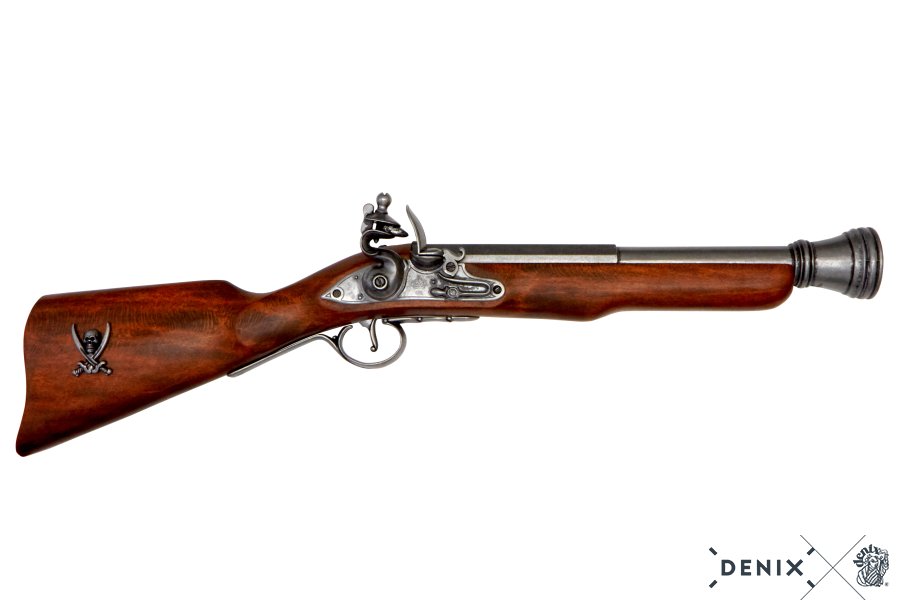DENIX BRITISH PIRATE BLUNDERBUSS 18TH. C BLACK POWDER MUSKET GUN – 1094/G
Real wood and metal , full sized replica 18th century blunderbuss with moving hammer , black powder cover and dry fire action to simulated mechanism of loading and firing. Quality piece measuring 74cm long and weighing 2kg. Blunderbusses were typically very short, with barrel less than 60 cm of length, at the same time, musket’s barrel measured more than 90 cm. The firing mechanism was based on a flint or flint stone, which the hammer produced the spark that ignited the gunpowder. All these blunderbusses required the manual recharge of their ammunition, which was inserted through the mouth of the barrel after each shot. Usually the weapon was loaded with a single bullet of lead, although also could be used with several bullets of smaller size (pellets). Used by the pirates in the eighteenth century, the blunderbuss was very imprecise, but was more useful in the approaches, during the naval battles, where the combat was at short distance. In addition, these weapons were used for a single shot, since their recharge method was very slow and there was not time available to recharge it. Therefore the fighters after firing were forced to draw their sabers or swords or to use […]
$395.00
7 in stock
Real wood and metal , full sized replica 18th century blunderbuss with moving hammer , black powder cover and dry fire action to simulated mechanism of loading and firing. Quality piece measuring 74cm long and weighing 2kg.
Blunderbusses were typically very short, with barrel less than 60 cm of length, at the same time, musket's barrel measured more than 90 cm. The firing mechanism was based on a flint or flint stone, which the hammer produced the spark that ignited the gunpowder.
All these blunderbusses required the manual recharge of their ammunition, which was inserted through the mouth of the barrel after each shot. Usually the weapon was loaded with a single bullet of lead, although also could be used with several bullets of smaller size (pellets).
Used by the pirates in the eighteenth century, the blunderbuss was very imprecise, but was more useful in the approaches, during the naval battles, where the combat was at short distance. In addition, these weapons were used for a single shot, since their recharge method was very slow and there was not time available to recharge it. Therefore the fighters after firing were forced to draw their sabers or swords or to use the pistol as a bludgeon, since the circumstances did not allow to recharge it in time.

















Reproduction of flintlock blunderbuss made of metal and wood with simulated mechanism of loading and firing.
Blunderbusses were typically very short, with barrel less than 60 cm of length, at the same time, musket's barrel measured more than 90 cm. The firing mechanism was based on a flint or flint stone, which the hammer produced the spark that ignited the gunpowder.
All these blunderbusses required the manual recharge of their ammunition, which was inserted through the mouth of the barrel after each shot. Usually the weapon was loaded with a single bullet of lead, although also could be used with several bullets of smaller size (pellets).
Used by the pirates in the eighteenth century, the blunderbuss was very imprecise, but was more useful in the approaches, during the naval battles, where the combat was at short distance. In addition, these weapons were used for a single shot, since their recharge method was very slow and there was not time available to recharge it. Therefore the fighters after firing were forced to draw their sabers or swords or to use the pistol as a bludgeon, since the circumstances did not allow to recharge it in time.
Live with the historical reproduction of this DENIX blunderbuss the pirate adventures and misadventures in the Caribbean seas!
It is an offence to sell replica firearms and knives to anyone under the age of 18. We will not sell these items or post them to anyone under the age of 18.
WE POST WITHIN AUSTRALIA ONLY FOR THESE REPLICA FIREARMS – SO NO OVERSEAS SALES ALLOWED. Posting out within 24 hours of being ordered. The item is a replica weapon. It is designed to resemble in shape, size, weight and basic functionality the firearm it represents. It has basic working parts and or removable parts (check description) and is a genuine Kolser or Denix/Spanish made item. The replica comes in its factory card box. Whilst this replica can be cocked and ‘dry fired’, it cannot fire, nor can it be altered to fire live rounds. These are not intended to be used outside of your private residence and frequent use and or rough play may result in damage to the item which will not be covered by return warranty under Australian Consumer law. No license is required or permit needed to purchase from us if you live in WA, SA and QLD. JB Military Antiques is not responsible for any paperwork you may need to own this product in your locality. We cannot give legal advice to anyone in regards to these replica firearms and suggest that if you have any questions, you contact your local Police Firearms branch for further details.
Additional information
| Weight | 5 kg |
|---|---|
| Dimensions | 90 × 15 × 15 cm |













